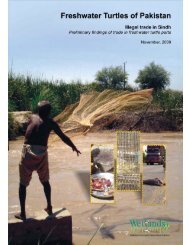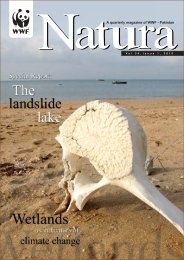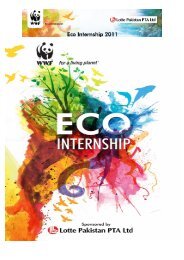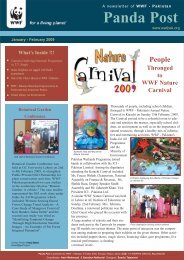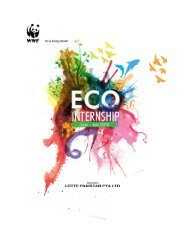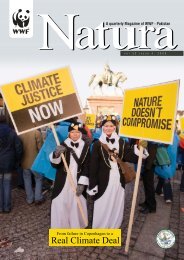Freshwater Turtles of Pakistan
Freshwater Turtles of Pakistan2-2007 - WWF-Pakistan
Freshwater Turtles of Pakistan2-2007 - WWF-Pakistan
You also want an ePaper? Increase the reach of your titles
YUMPU automatically turns print PDFs into web optimized ePapers that Google loves.
2. Literature reviewed<br />
Akbar et al (2006) identified eight species <strong>of</strong> freshwater turtles from the rivers in Punjab. The<br />
most abundant species found was Kachuga smithii (43.62 %) followed by Kachuga tecta<br />
tecta (42.06 %). The status <strong>of</strong> Hardella thurjii and Chitra indica was rare (0.88 % and 0.54 %<br />
respectively), whereas the status <strong>of</strong> Geoclemys hamiltonii (1.76 %) Aspideretes hurum (3.09<br />
%) and Lissemys punctata (1.50 %) was recorded as frequent and that <strong>of</strong> Aspideretes<br />
gangeticus (6.55 %) as common 10 .<br />
Dr. Khalid Javed Baig in his report <strong>of</strong> Taunsa visit in May 2006 mentioned that a family <strong>of</strong><br />
about 40 persons, camping at Taunsa Barrage for two months killed Chitra indica and<br />
Aspideretes gangeticus to obtain plastron and chest pellicles. They could collect over 200<br />
turtles every week and were selling their parts for Rs. 100-200 to buyers.<br />
The <strong>Pakistan</strong> Wetlands Programme team in its visit to Dera Ismail Khan (North West Frontier<br />
Province) on April 17 th -22 nd 2007 found that the communities called Kails residing along the<br />
River sides were involved in capturing Aspideretes gangeticus and Aspideretes hurum to<br />
obtain plastrons and chest-pellicles. These parts are then exported to the international<br />
markets (China) through an extensive network <strong>of</strong> local middlemen. These communities have<br />
been capturing turtles since December 2006 and are paid minimum <strong>of</strong> Rs.50-60 and<br />
maximum <strong>of</strong> Rs.250 for a piece <strong>of</strong> plastron and chest-pellicle. Minimum capture is 37<br />
s<strong>of</strong>tshell turtles per day. The sites visited in D.I.Khan are shown on the map in figure 1.<br />
3. Objectives <strong>of</strong> the study<br />
q Meeting with <strong>of</strong>ficials <strong>of</strong> the provincial wildlife departments to discuss legal status <strong>of</strong><br />
freshwater turtles;<br />
q Know measures taken by the wildlife departments to stop illegal hunting <strong>of</strong> freshwater<br />
turtles;<br />
q Identify areas to define scope <strong>of</strong> field work involving freshwater turtles;<br />
q Establish baseline data <strong>of</strong> freshwater turtles and trade in their parts; and<br />
q Identify threats and recommend actions to conserve freshwater turtles.<br />
4. <strong>Freshwater</strong> turtles and the <strong>Pakistan</strong> Wetlands Programme<br />
<strong>Pakistan</strong> has a broad spectrum <strong>of</strong> biodiversity that include 225 significant wetlands, which<br />
cover about 10 % <strong>of</strong> the country. Wetlands are generally degrading due to various human<br />
induced threats. The Ministry <strong>of</strong> Environment’s “<strong>Pakistan</strong> Wetlands Programme”, is a seven<br />
years programme, implemented by the World Wide Fund for Nature-<strong>Pakistan</strong>. The<br />
programme aims at conserving important wetlands <strong>of</strong> <strong>Pakistan</strong> and the associated<br />
biodiversity.<br />
The Central Indus Wetlands Complex (CIWC) is one <strong>of</strong> the demonstration sites <strong>of</strong> <strong>Pakistan</strong><br />
Wetlands Programme. It consists <strong>of</strong> a continuum <strong>of</strong> wetlands resources along the main stem<br />
<strong>of</strong> the Indus River between the town <strong>of</strong> Chashma in the north and the city <strong>of</strong> Sukkur in the<br />
south. The main output <strong>of</strong> Central Indus Wetlands Complex is to conserve riverine<br />
biodiversity in the designated area by implementing an inter-related suite <strong>of</strong> interventions<br />
that are essentially community-based, sustainable and poverty alleviating. Map <strong>of</strong> the<br />
Central Indus Wetlands Complex showing the sites visited for freshwater turtle survey is<br />
given in figure 1.<br />
5. Methodology<br />
Methodology adopted includes the combination <strong>of</strong> both direct and indirect observations.<br />
Page 10 <strong>of</strong> 23 <strong>Freshwater</strong> Turtle Survey, 2007





